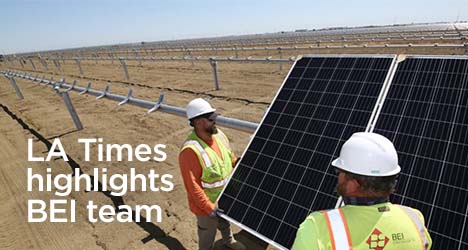Constructing Data Centers that Power Artificial Intelligence (AI) Learn More
LA Times highlights BEI Construction team and project

A recent article in the Los Angeles Times featured a BEI Construction employee and one of our projects. The newspaper interviewed Anthony Romano, an electrician and general foreman with BEI Construction, about his perspective on union jobs in the booming solar industry. Journalists found Romano on-site at the Westlands Solar Park, a current BEI project led by Swinerton Renewable Energy.
From a job in roofing to a career with BEI
The LA Times article focuses on the growth of jobs in the solar industry in California. Some of those jobs have not been union jobs, but the people building the Westlands Solar Park are members of unions. Romano told reporters that he got his start in the roofing industry. An apprenticeship program offered by the International Brotherhood of Electrical Workers (IBEW) union launched him into a career as an electrician.
According to Romano, “It was an interesting experience being interviewed by journalists. As I told them, the union helped me get started in my career as an electrician. BEI and the IBEW both make quality a priority. Now, I have a career helping to build our clean energy future.”
Renewable energy and union jobs
The article explores some of the issues raised by the growth of the renewable energy industry. Unlike at Westlands, some jobs in the solar industry aren’t union. But there’s an interest on the part of the Biden administration to ensure that union jobs become more prevalent in the industry. BEI Construction supports this goal.
“BEI Construction is an IBEW union electrical contractor,” says BEI President Mike Rantz. “We’re affiliated with other unions too. Unions support quality and safety. As Anthony Romano highlights in the Times article, unions help people acquire in-demand skills. We’re proud to play a role in building visionary projects like Westlands with union members.”
About Westlands Solar Park
Located in California’s San Joaquin Valley, Westlands Solar Park will begin operations by the end of 2021. When complete, the multi-phase project will have an installed capacity of 2.7GW, which is enough to power more than 750,000 homes. The location is unusable for agriculture due to excess salt in the soil, making the 21,000-acre site ideal for solar energy generation.